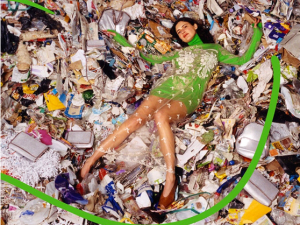In our first series of blogs, we look at the modern phenomenon that is the fast fashion industry and its impact on the environment. Published weekly in 4 instalments, we will explain how fast fashion came to be, why it needs to change, and, crucially, what we the general public can do to help.
In our first post, we find out how our insatiable desire to keep track with the latest trends is having a serious impact on our planet.
By Nadin Moustafa, PhD student in the Department of Chemical Engineering.

We’ve done more damage to our environment in the past 100 years, than we have in the world’s history. Governments, companies, industries and individuals are all trying to work towards a more sustainable future. One of the important things to realise in my opinion, is that we cannot fix one thing and expect everything else to fall in place. There are so many topics we need to focus on. One of the major topics that has been highlighted recently is fast fashion. “Fast fashion” is a term that we are becoming increasingly aware of but what does it mean? And why is it a big problem? Fast fashion is essentially the production of cheaper clothes, with less quality as often as possible. On average, fashion companies went from producing two collections per year in 2000 to five in 2011. In 2012, Zara was able to produce and deliver new collections in two weeks; Forever 21 in six weeks and H&M in eight weeks. On average people bought 60% more garments in 2014 than they did in 2000 and they only kept clothes for half as long (McKinsey & Company, Ellen MacArthur). This a problem because the fashion industry has a disastrous impact on the environment including depletion of non-renewable resources, emission of greenhouse gases and use of significant amounts of water and energy. The Quantis International report found that the three main drivers for the industry’s environmental impact are dyeing & finishing (36%), yarn preparation (28%) and fiber production (15%).
Greenhouse Gas Emissions
IPCC calculated the industry is accountable for 10% of the global CO2 emissions. That’s more emissions that all international flights and maritime shipping combined (UNEP, 2018). The polyester production for textiles alone was equal to the amount of CO2 released from 185 coal-fired power plants in 2015. If the fashion sector continues on its current trajectory their share of carbon budget will increase to 26% by 2050 (Ellen MacArthur Foundation, 2017). By 2030, it is estimated that global middle class will increase to 5.4 billion people as opposed to 3 billion in 2015. Thus, the demand for fast fashion is expected to increase and we will need three times as many natural resources by 2050 when compared to 2000 (UNEP, 2018).
Environmental impact
The fashion industry is the second-largest consumer of water worldwide (UNECE, 2018). Cotton is a water intensive plant so the production of one cotton shirt uses more than 3000 L of water. As if that wasn’t enough, a pair of jeans uses more than 9000 L of water. That’s enough for a person to drink ~2.4 L per day for 3.5 & 10 years respectively. In 2018, more than 4.5 billion pairs of jeans were sold worldwide (Lacombe, 2018)! That would’ve been enough water for 4.5 billion people to drink for 10 years; 780 million people do not have access to an improved water source (World Health Organisation and UNICEF, 2012).

The industry also pollutes the oceans with microplastics. This is because washing clothes releases 500,000 tons of microfibers into the ocean every year. That is the equivalent of 50 billion plastic bottles (UNEP, 2018), (Ellen MacArthur Foundation, 2017). A 2017 report from the International Union for Conservation of Nature (IUCN) found that the fashion industry contributes to 31% of the overall plastic pollution in the ocean (IUCN, et al., 2017). Apart from emissions & textile production, textile dyeing is the world’s second largest polluter of water, since leftovers are dumped into streams or rivers (UNEP, 2018). Wastewater from textile dyeing has determinantal effects. Some dyes do not degrade. Whereas dyes that do degrade produce harmful substances as thy decompose, which effects plant life in the water. Azo dyes, which are a class of synthetic nitrogen-based dyes are cost effective to produce but have toxic and carcinogenic effects (Lellis, et al., 2019). What’s more, more 85% of all textiles are dumped each year. One garbage truck of clothes is burned or dumped in a landfill every second according to UNEP. Since recycling in the fashion industry is still facing a lot of challenges, less than one percent of all materials used in clothing is recycled back to clothing (Sajn, 2019).
Can fashion be sustainable?
The fashion industry is not going anywhere (I for starters sincerely hope it doesn’t)! However, the important question is, how do we make it sustainable? The industry needs to fundamentally change in order to mitigate its environmental impact. There are several ways to work towards a greener fashion industry. Those include embracing renewable energy, developing new methods for recycling, using a biodegradable and/or sustainable substitute to polyester and finally, producing better-quality, long-lived products. It is important to not only research into those possibilities but to focus on how to scale them and make them commercially viable.
Bibliography
UNEP, 2018. Putting the brakes on fast fashion. [Online]
Available at: https://www.unenvironment.org/news-and-stories/story/putting-brakes-fast-fashion
Ellen MacArthur Foundation, 2017. A new textiles economy: Redesigning fashion’s future. [Online]
Available at: https://www.ellenmacarthurfoundation.org/assets/downloads/publications/A-New-Textiles-Economy_Summary-of-Findings_Updated_1-12-17.pdf
UNECE, 2018. Fashion and the SDGs: what role for the UN?. [Online]
Available at: https://www.unece.org/fileadmin/DAM/RCM_Website/RFSD_2018_Side_event_sustainable_fashion.pdf
Lacombe, G., 2018. Global jeans market set to grow to $60 billion by 2023. [Online]
Available at: https://us.fashionnetwork.com/news/Global-jeans-market-set-to-grow-to-60-billion-by-2023,1041775.html
World Health Organisation and UNICEF, 2012. Progress on Drinking Water and SAnitation: 2012 Update, s.l.: WHO/UNIVEF.
Ellen MacArthur Foundation, 2017. One garbage truck of textiles wasted every second: report creates vision for change. [Online]
Available at: https://www.ellenmacarthurfoundation.org/news/one-garbage-truck-of-textiles-wasted-every-second-report-creates-vision-for-change
IUCN, Boucher, J. & Damien, F., 2017. Primary microplastics in the oceans: a global evaluation of sources. [Online]
Available at: https://portals.iucn.org/library/node/46622
Lellis, B., Favaro-Polonio, C. Z., Pamphile, J. A. & Polonio, J. C., 2019. Effects of textile dyes on health and the environment and bioremediation potential of living organisms. Biotechnology Research and Innovation , Volume 3, pp. 275-290.
Sajn , N., 2019. Environmental impact of the textile and clothing industry; what consumers need to know. [Online]
Available at: https://www.europarl.europa.eu/RegData/etudes/BRIE/2019/633143/EPRS_BRI(2019)633143_EN.pdf